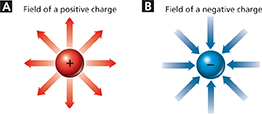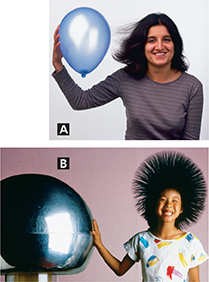Figure 4 The strength of an electric field depends on the amount of charge that produces the field and on the distance from the charge. A The electric field around a positive charge points outward. B The electric field around a negative charge points inward.
 d
dElectric Fields
The effect an electric charge has on other charges in the space around it is the charge's electric field. Figure 4 shows the fields of positive and negative charges.  The strength of an electric field depends on the amount of charge that produces the field and on the distance from the charge. The lines representing the field are closer together near the charge, where the field is stronger.
The strength of an electric field depends on the amount of charge that produces the field and on the distance from the charge. The lines representing the field are closer together near the charge, where the field is stronger.
Figure 5 Charge can be transferred by friction and by contact. A Friction transferred electrons from the hair to the balloon. The balloon then attracts the hair because opposite charges attract. B A Van de Graaff generator has charged the metal sphere. Touching the sphere transfers charge. The hairs repel each other because like charges repel.

An electric field exerts forces on any charged object placed in the field. The force depends on the net charge in the object and on the strength and direction of the field at the object's position. The more net charge an object has, the greater is the force on it. The direction of each field line shows the direction of the force on a positive charge.
Static Electricity and Charging
Static electricity is the study of the behavior of electric charges, including how charge is transferred between objects. There are several ways that a net charge can build up on an object or move from one object to another.  Charge can be transferred by friction, by contact, and by induction. Keep in mind that whenever there is a charge transfer, the total charge is the same before and after the transfer occurs. This is the law of conservation of charge the total charge in an isolated system is constant.
Charge can be transferred by friction, by contact, and by induction. Keep in mind that whenever there is a charge transfer, the total charge is the same before and after the transfer occurs. This is the law of conservation of charge the total charge in an isolated system is constant.
Charging by Friction
The balloon in Figure 5A attracts hair because opposite charges attract. But how do balloons and hair pick up a net charge? Rubbing a balloon on your hair is an example of charging by friction. Electrons move from your hair to the balloon because atoms in rubber have a greater attraction for electrons than atoms in hair. The balloon picks up a net negative charge. Because your hair loses electrons, it becomes positively charged. Even simple everyday activities like walking across a carpet can build up charge this way.
Charging by Contact
Why do the girl's hairs repel each other in Figure 5B? In this case, charge is transferred by contact. A Van de Graaff generator has charged the metal sphere. When the girl touches the sphere, she acquires a charge large enough to make her hairs stand on end. The sphere is still charged, but its net charge is reduced.




